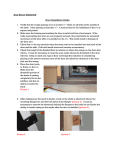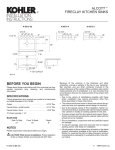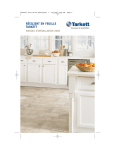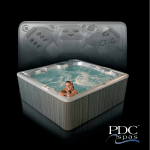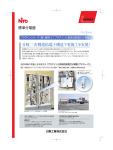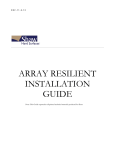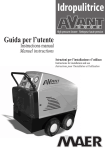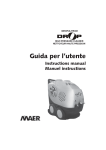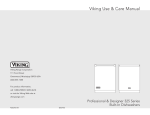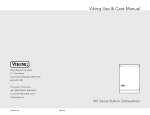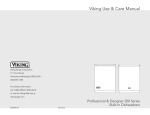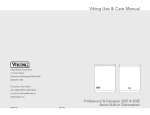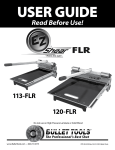Download Tarkett® NAFCO® Luxury Floors 2010 Residential Installation Manual
Transcript
Tarkett® NAFCO® Luxury Floors 2010 Residential Installation Manual II Table of contents Chapter 1: SUBFLOORS AND UNDERLAYMENTS 3 Grade Levels........................................................................... 3 Concrete................................................................................. 3 Wood Substrates...................................................................... 8 Other Types of Substrates...................................................... 11 Chapter 2: Nafco adhesives 13 Nafco 400 (Wet Set) Adhesive................................................ 13 Nafco 800 (Pressure Sensitive) Adhesive................................. 13 Nafco 850 Adhesive............................................................... 14 Nafco Quik-Stik Tile.............................................................. 15 Nafco 700 (Wall Base) Adhesive............................................. 15 Chapter 3: Luxury Vinyl Tile Lay Out and Installation 17 Square Layout....................................................................... 17 Diagonal Layout.................................................................... 18 Installing Border Tile............................................................. 20 Chapter 4: Permastone® Modular Layout and Installation 21 Installing Modules................................................................. 21 Installing Single 8” x 16” Tiles.............................................. 22 Chapter 5: Groutfil™ Layout and Installation 23 Square Layout....................................................................... 23 Diagonal Layout.................................................................... 23 Installing Border Tile............................................................. 25 Nafco GroutFil™ Premixed Grout............................................. 25 Chapter 6: Luxury Vinyl Plank Layout and Installation 27 Square Layout....................................................................... 27 Diagonal and Herringbone Layout........................................... 27 Chapter 7: Cove Base Installation 31 Substrate Preparation............................................................ 31 Installation of Wall Base........................................................ 31 Nafco Quik-Stick Wall Base.................................................... 32 1 2 Chapter 1: SUBFLOORS AND UNDERLAYMENTS Grade Levels Suspended – An acceptable suspended floor is a concrete or wood substrate with a minimum of 18” (460mm) of well-ventilated air space below. It is recommended that a 10mil polyethylene moisture vapor barrier be placed upon the ground beneath the air space. On grade – An acceptable on-grade floor is a concrete substrate in direct contact with the ground or over a fill in direct contact with the ground. Properly constructed, the concrete slab will be suitably protected from moisture penetration by planned water drainage and an installed proven moisture vapor barrier. Below grade – An acceptable below grade floor is a concrete substrate partially or completely in contact with the ground below the average surrounding grade level. Properly constructed the concrete slab will be suitably protected from moisture penetration by planned water drainage and an installed proven moisture vapor barrier. The following example displays these three types: Definitions Subfloor: Provides structure and support for the underlayment. Underlayment: The smooth surface, which the floor covering is to be installed upon. Subfloor/Underlayment System: The required surface that provides both structure and support with the necessary smooth surface for Tile floor coverings. These systems must be 1 inch total thickness and double-layered construction. Sleeper: Construction of a wood subfloor system over the top of a concrete substrate. Although some of these may provide adequate support, due to the possibility of moisture transmission from the concrete substrate they are not recommended as a substrate for installation of NAFCO Tile flooring. CONCRETE Note: Regardless of the type of concrete or cement-like material used as a base for NAFCO Tile flooring the responsibility for use or suitability rests with this products manufacturer or specifier, not with NAFCO. All concrete floors, old or new, should be tested for moisture and proper bonding of the Tile flooring. NAFCO tile flooring may be installed on all grade levels. Concrete floors shall be constructed in accordance with the American Concrete Institute (ACI) 302.1 R-96 Guide for Concrete Floor and Slab Construction and ACI 360R Slabs on Grade with a minimum compressive strength of 3500 psi. In some cases, shrinkage compensating concrete is used to minimize or eliminate cracking caused by dry shrinkage in floor slabs. Such slabs should be constructed in accordance with ACI 223-83 Standard Practice for the Use of Shrinkage Compensating Concrete. These guides and practices are available from the American Concrete Institute, P.O. Box 9094, Farmington Hills, MI, 48333. The single most important consideration affecting tile flooring installations is knowledge and proper preparation of the construction site. Prevention of moisture and alkaline transmission through the slab into the adhesive film and Tile flooring eliminates potential problems. 3 Proper site preparation, slab construction and the use of an effective moisture vapor retarder will make a successful installation more likely. A 10 mil polyethylene sheet or equal is recommended. The sheet must remain intact and must not be damaged or ruptured prior to or during the concrete pour. Regardless of the age of an on, above or below grade concrete slab, installation failures can occur due to the presence of moisture in the slab. The moisture can come from the slab itself, if not completely dry or from the ground as the slab comes to equilibrium with ground moisture. A slab may seem dry, but actually has moisture passing through it and evaporating. As moisture passes through a slab, it can carry with it alkaline salts from the ground and/or slab itself. Moisture and alkali cause various installation problems such as adhesive deterioration, bumps or ridges, color change and mold and mildew growth. Any or all of these conditions might be expected to occur in an undeterminable period of time after installation if a severe moisture condition is present before, during or after installation. Installers and tile flooring manufacturers have little control over these factors. Installation failures due to the presence of moisture or alkali are not warranted by NAFCO. Although the dryness of an on or below grade concrete slab can be determined at the time of installation, it is not a guarantee that the slab will be free of excess moisture forever. Moisture Testing It is the flooring contractor’s as well as the installer’s responsibility to test all concrete substrates, both new and old, for moisture content to determine if it is sufficiently dry to install NAFCO tile flooring. A concrete slab shall be cured a minimum of 90 days (preferably 120 days) before running moisture tests. These time periods are absolute minimum and concrete may require additional drying time dependent upon local environment conditions. Moisture in the concrete should be tested according to ASTM F 1869 (Standard Test Method for Measuring Moisture Vapor Emission Rate of Concrete Subfloor Using Anhydrous Calcium Chloride). The Quantitative Calcium Chloride Moisture Test Kit contains anhydrous calcium chloride. It employs the principles of both chemical absorption and entrapment of moisture vapor. A pre-weighed amount of anhydrous calcium chloride stored and sealed in a clear plastic cylindrical container is placed on a clean area of the concrete slab to be tested. It is then unsealed, opened, and covered with a larger transparent plastic cover adhered to the slab with a moisture-tight sealant. The test is run for approximately 60 – 72 hours and the amount of moisture absorbed by the calcium chloride is determined and converted to pounds of moisture/1,000 square feet/24 hours. The results should be no more than 3 lbs./1,000 sq. ft./24 hours. Moisture vapor may also be tested using the relative humidity test ASTM F 2170 (Standard Test Method for Determining Relative Humidity in Concrete Floor Slabs Using in situ Probes). When tested according to this method, the internal relative humidity shall not exceed 75%. In areas 1,000 square feet or less, a minimum of three tests shall be made; for each additional 1,000 square feet, one additional test should be made. These tests should be made simultaneously and the test units should not be concentrated, but not closer than 5 feet from the edge. CAUTION: ALL MOISTURE TEST RESULTS ONLY INDICATE THE CONDITION OF A CONCRETE SLAB FOR THE ACTUAL AREA TESTED AND ONLY AT THE TIME OF THE TEST. ACCURATE TEST RESULTS WILL ONLY BE ACHIEVED WHEN TAKEN IN A ROOM ACCLIMATED TO ITS EXPECTED NORMAL ENVIRONMENTAL CONDITION. MOISTURE VAPOR EMISSION FROM CONCRETE SUBFLOOR VARIES BOTH FROM ONE AREA TO ANOTHER AND OVER TIME FOR NUMEROUS REASONS BEYOND THE CONTROL OF THE FLOORING CONTRACTOR OR INSTALLER. Although the dryness of an on or below grade concrete slab can be determined at the time of installation, it is not a guarantee that the slab will be free of excessive moisture forever. NOTE: NAFCO does not warrant or guarantee flooring problems caused by the presence of excessive moisture, alkali or hydrostatic pressure. 4 Surface Alkalinity on Concrete Substrate Concrete by its very nature is a highly alkaline material. Under normal conditions this situation does not affect Tile floor coverings and their adhesives. This does become a factor when concrete surface alkali salts build-up, usually as the result of excessive moisture vapor transmission through the concrete slab. Moisture carries alkali salts from the interior of the slab to the surface, which are left behind when the moisture evaporates. Excessive alkali has been known to degrade adhesives and tile floor coverings leading to poor appearance, maintenance difficulties, and in extreme cases, total floor failure. Measures of alkalinity are usually expressed in terms of a pH number. The normally encountered pH scale ranges from 1 to 14 with 7 being neutral. Numbers moving downward from 7 indicate increasing acidity and numbers moving upward from 7 indicate increasing alkalinity. Readings of pH in excess of 9 have been known to affect tile floor coverings and adhesives and are usually suggestive of excessive vapor/moisture transmission. The most common test performed for excessive surface alkali is the pH Paper Test. Materials required: Wide range pH Test Paper (obtained from chemical/scientific supply house). Distilled Water Eye Dropper The pH Test paper will change color when in contact with dissolved alkali salts. Reading of pH on the 1 through 14 scale can be determined by comparing paper color after exposure to chart provided by pH Test paper supplier. Concrete floors to be tested must be clean, dust free, and at normal room temperature. NOTE: Drywall dust, subfloor patching compounds, and other contaminates will influence test results. Several drops of Distilled Water are deposited on the test point with the clean eye dropper (enough to form a quarter sized puddle), allow to react for 2-3 minutes, pH Test paper strips are placed into the water spot. Between 30 seconds and 1 minute after test strips are placed into water, color of the test strips are compared to the chart and a pH number reading is determined. Readings of pH in excess of 9 have been known to affect tile floor coverings and adhesives and are usually suggestive of excessive vapor/moisture transmission. Washing the concrete with clean water can lower alkalinity. However, it cannot prevent future deposits of alkali on the surface of concrete. Acid washes have been used to neutralize alkalinity, but it is important to remember that acids can leave a residue, which can be detrimental to the final installation. Sealers, Curing and Parting Compounds Sealers, curing and parting compounds used on concrete substrates may not be compatible with the adhesive and may interfere with the adhesion of the flooring material. Therefore, NAFCO does not recommend the use of such products. These products shall be removed using a terrazzo grinding machine or by sanding with a drum sander. A bond test shall be performed to determine if adhesion properties are acceptable. Bond Test A bond test shall be performed on all grade levels of concrete substrates to determine if the concrete is sufficiently dry and if a sealer, curing or parting compound was used. Install a few pieces of the flooring material selected for the installation and adhere with the recommended NAFCO adhesive. Pay particular attention to the adhesive open time. If after 72 hours an unusual amount of force is required to lift the material from the substrate, and if after doing so, adhesive transfers to both the substrate and to the back of the flooring, the flooring can be considered “securely bonded.” NOTE: Regardless of the bond test or the type of surface treatment used, the responsibility for warranties, guarantees, and performance of a concrete substrate on which a surface treatment has been applied rests with the manufacturer of the surface treatment product for adhesion and/or patching compound failures and not with NAFCO. 5 Mat Moisture Test The mat moisture test is a good method for determining if moisture is present. Place a 3’ x 3’ piece of 10mil or thicker polyethylene on the concrete. Securely tape all edges of the sheet with duct tape so no air can penetrate. After 24 hours, remove the sheet and inspect for any evidence moisture. If the covered area of concrete appears wet, darker in color or if there is moisture on the polyethylene sheet, do not install the flooring. The concrete shall be given additional time to dry and then retested. Floor Flatness The surface flatness or levelness will affect the finished appearance of tile floor coverings. Installation of tile flooring products over an excessively uneven or undulating concrete slab will require working techniques on the part of the installation contractor that would include leveling and smoothing. It is recommended that both flatness and levelness requirements be described by Face Floor Profile Numbers (F-numbers). Refer to the American Concrete Institute ACI 302.1 Guide for Concrete Floor and Slab Construction. Painted Floors NAFCO does not recommend installation of tile flooring over painted surfaces. All paint must be removed from the surface to be covered. CAUTION: Certain paints may contain lead. Exposure to excessive amounts of lead dust presents a health hazard. Refer to applicable federal, state and local laws and Lead-Based Paint Interim Guidelines for hazard Identification and Abatement in Public and Indian Housing (Sept. 1990) or subsequent editions published by the U.S. Department of Housing and Urban Development regarding: (1) appropriate methods for identifying lead-based paint and removing such paint; and (2) any licensing, certification, and training requirements for persons performing lead abatement work. Radiant Heated Floors NAFCO tile flooring may be installed over radiant heated floors, provided the operating temperature does not exceed 85ºF (29.4ºC). Tarkett 400 Adhesive must be used for both plank and tile installations. NOTE: During installation, lower the radiant heated floor temperature to a minimum 65ºF (18.3ºC). This temperature should be maintained for at least 24 hours before, during and 48 hours after completion of the installation. On ground floors the radiant heating system should have a proper moisture barrier beneath it. The concrete should be tested for moisture before the tile flooring is laid. Heating pipes must be at least 2” (50 mm) below the floor surface. If the heating pipes are too close to the vinyl flooring, the vinyl may discolor next to the pipe work. Gradually increase temperature in increments of 5° per hour. Lightweight Concrete Lightweight concrete substrate either aggregate or cellular should first be determined as suitable for the installation of NAFCO tile flooring. At a minimum, lightweight aggregate concrete should have dry densities greater than 90 lbs. per cubic foot and cellular concrete should have wet densities over 100 lbs. or 94 lbs. dry weight per cubic foot. Lightweight concrete may contain excessive moisture and must be tested to determine if it is dry enough to install NAFCO tile flooring. In locations where heavy static or dynamic (rolling) loads will occur, concrete should be designed at the construction planning stage to accommodate this need. NOTE: NAFCO does not recommend or warrant the use of products containing gypsum as a satisfactory underlayment for the installation of NAFCO Tile flooring. Concrete Preparation Prior to installation of NAFCO tile flooring, the concrete shall be prepared in accordance with ASTM F 710 Preparing Concrete Floors to Receive Resilient Flooring. The surface of the concrete must be 6 dry, clean, smooth, level and structurally sound. The slab shall be swept, damp mopped and/or vacuumed to remove any dust. Any surface materials present such as paint, wax, grease, oil, adhesive residues, crayon, pen marking, etc. that may prevent a proper bond or migrate to the surface of the flooring causing discoloration, must be removed. Fill and level any cracks, construction joints, control joints, depressions, grooves or other irregularities with a high quality, non-shrinking, latex fortified, cementitious patching compound. NOTE: NAFCO does not recommend or warrant the use of any products containing gypsum as a satisfactory patching compound for installation of NAFCO tile flooring. NAFCO will not accept responsibility for flooring failures related to the use of gypsum type patching and/or leveling compounds. Expansion Joints Expansion joints allow for movement between two concrete slabs. If tile flooring is installed over an expansion joint, adhesive bond failure, buckling and cracking of the flooring material is likely to occur. Do not install NAFCO Tile flooring over expansion joints. Flooring material shall be cut to either side of the joint and then covered with an expansion joint cover. Use a cover that will provide a smooth transition and prevent a tripping hazard. Self-Leveling Compounds There are a large number of these products available on the market today with various compositions and performance characteristics. They have been recommended by their manufacturers for smoothing rough or irregular subfloors, encapsulating asbestos containing flooring and adhesives, for acoustical or for certain fire prevention characteristics as well as other concerns. A cementitious, latex reinforced type having a minimum compressive strength of 3,500 PSI or greater is recommended. We do suggest they be obtained from a quality manufacturer that provides a warranty for this product’s use as a tile flooring underlayment. Manufacturers such as “Ardex®” and “Mapei®” have products that meet these criteria for self-leveling and should be contacted for further information. NOTE: All warranties and guarantees regarding the suitability and performance of these products, rests with the levelers manufacturer or the installation contractor, not with NAFCO. Residual Adhesives All existing residual adhesive must be removed or covered with an approved self-leveling compound designed for this purpose. The leveler must be recommended for use as an underlayment for installation of NAFCO tile flooring. Manufacturers such as “Ardex®” and “Mapei®” have products that meet these criteria for self-leveling and should be contacted for further information. Removal of adhesive residues over plywood is very difficult. Therefore, installation of new underlayment is recommended. Lay thin sheets of paper over residual adhesive prior to installing new underlayment. NAFCO does not recommend the use of solvent-based adhesive removers. These products leave a residue within the substrate that can adversely affect the new adhesive and flooring material. ! WARNING DO NOT SAND, DRY SWEEP, SCRAPE, DRILL, SAW, BEADBLAST OR MECHANICALLY PULVERIZE EXISTING RESILIENT FLOORING, BACKING, LINING FELT OR ASPHALTIC “CUT-BACK” ADHESIVES. THESE PRODUCTS MAY CONTAIN EITHER ASBESTOS FIBERS OR CRYSTALLINE SILICA. AVOID CREATING DUST. INHALATION OF SUCH DUST IS A CANCER AND RESPIRATORY TRACT HAZARD. SMOKING BY INDIVIDUALS EXPOSED TO ASBESTOS FIBERS GREATLY INCREASES THE RISK OF SERIOUS BODILY HARM. UNLESS POSITIVELY CERTAIN THAT THE PRODUCT IS A NON-ASBESTOS CONTAINING MATERIAL, YOU MUST PRESUME IT CONTAINS ASBESTOS. REGULATIONS MAY REQUIRE THAT THE MATERIAL BE TESTED TO DETERMINE ASBESTOS CONTENT. Instructions for removal of existing flooring and residual adhesives can be found in the Recommended Work Practices Manual for the Removal of Tile Floor Coverings. This manual can be obtained from The Tile Floor Covering Institute, 966 Hungerford Dr., Suite 12-B, Rockville, MD, (301) 340-8580. 7 WOOD SUBSTRATES Wood Substrate Construction: Suspended wood substrates shall be 1” or thicker, doubleconstruction, strongly constructed, free from spring and have minimum of 18” of well-ventilated air space clearance above the ground. A moisture vapor retarder (10 mil or thicker polyethylene sheeting) should be installed over the ground with overlapped widths and lengths, to reduce moisture vapor transmission. The joists shall be spaced not more than 16-inches (406 mm) on centers. If joists are warped or twisted, have high crowns, or otherwise do not present a flat, true base for the substrate, these conditions must be corrected before installing substrate. All substrate panels must be fastened to the joists in accordance with their manufacturer’s recommendations to preserve their warranties. NOTE: Protruding fasteners must be made flush with the surface of the subfloor panels before beginning installation of underlayment. Single Wood Floors: Single plywood subfloors are not recommended in areas where tile flooring is to be installed. They are the major cause of nails popping and squeaking. These subfloors must be covered with a minimum of ¼” or thicker underlayment grade plywood. Stripwood Substrates: Single and/or double tongue-and-groove stripwood floors should be covered with a 3/8” or thicker underlayment grade plywood to eliminate telegraphing of the stripwood floorboard joints. Plywood Underlayment Underlayment grade plywood is used to resurface an existing wood subfloor. The finished appearance of any tile flooring installation will be determined in part by the underlayment over which it is installed. Underlayment grade plywood used for tile flooring shall meet the following requirements: • Be ¼” or thicker with a fully sanded face. • Be structurally sound with no voids and dimensionally stable • Designed for use with tile flooring. • Texturing or graining will not telegraph through the flooring. • Withstand damage from heavy loads. • Be free of any substances that may stain flooring The underlayment panels listed and their recommendation for use with NAFCO tile flooring are intended only as a guide. The underlayment selected is subject to the discretion of the installer. NAFCO strongly suggests that when purchasing underlayment, a warranty and installation instructions be obtained from the supplier. RECOMMENDED UNDERLAYMENT PANELS • APA Underlayment Grade Plywood A-C, B-C, C-C Plugged. • ACCU-PLY • IntegraPly • SurePly • TECPLY • ULAY • Ultraply • C.S.A. (CanPly) • Proboard NAFCO CANNOT WARRANT OR GUARANTEE UNDERLAYMENT PANELS USED WITH NAFCO TILE FLOORING. THE RESPONSIBILITY FOR WARRANTIES, GUARANTEES AND PERFORMANCE OF THE UNDERLAYMENT PANELS RESTS WITH THE MANUFACTURER OF THE UNDERLAYMENT AND NOT WITH NAFCO. NAFCO will not accept responsibility for the following: • Joint or texture telegraphing. • Tunneling or ridging over underlayment joints. • Discoloration originating from underlayment panel unless otherwise specified in the product warranty. CAUTION: Some plywood underlayment manufacturers use plastic or resin filler to patch surface voids. Some filler can cause discoloration in vinyl flooring, specify plywood underlayment with wood plugs and fills. All underlayment panels other than those listed are not recommended for use with NAFCO Tile flooring. 8 APA Rated Sturd-I-Floor Construction NAFCO does not recommend installation of tile flooring directly over Sturdi-I-Floor. Install ¼” or thicker underlayment grade plywood over these type panels. AdvanTech® Flooring NAFCO does not recommend installation of tile flooring directly over AdvanTech® Flooring. Install ¼” or thicker underlayment grade plywood over these type panels. Lauan or Maranti Plywood A wide variety of species and grades of Lauan or Maranti plywood have been imported into North America and sold for use as underlayment. Although they do not have all the preferred properties for underlayment, many retailers are using these panels under Tile flooring with reasonable success. If Lauan or Maranti is used, it should be classified as Type 1, Exterior (Ext), which indicates the panel has an exterior glue bond. This may also be designated by the letters “BB” or “CC”. However, many of these panels have caused severe problems such as discoloration, delamination and adhesive failures. Construction Adhesives Certain industrial grade adhesives used in the construction trade to adhere subfloor panels have been known to discolor resilient flooring products even if covered over with plywood underlayment or trowelable underlayments. Any construction adhesives used in subfloor construction must be guaranteed to be non-staining for resilient flooring materials by its manufacturer. NAFCO will not accept responsibility for discoloration problems related to the use of construction adhesives. Storage and Handling Underlayment panels should be stored indoors in a dry, covered area. Panels shall be laying flat over a minimum of two supports. It is extremely important for both remodeling and new construction applications that the underlayment panels be allowed to acclimate to room conditions and that the underlayment panels are protected from extremes of heat and moisture before, during and after installation. Installing Underlayment Panels Installation of underlayment panels shall be performed in accordance with their manufacturer’s recommendations to preserve their warranties. Laying the underlayment panels should begin in one corner of the room. Lay all underlayment panels in the same direction. Underlayment panel edges and subfloor edges should be offset at least 8”. A space of ¼” to 3/8” shall be left between the panels and the wall around the perimeter of the room. Stagger panel joints so that four corners do not meet. Cross joints should be staggered at least 16”. The panel edges shall be lightly butted to together. New underlayment shall not be installed over heavily cushioned flooring. These will not provide a firm base for underlayment application resulting in deflection or scissoring action at the seams. Telegraphing of underlayment joints and nail pops will also occur. Fastening Panels Nails: Cement coated or resin coated fasteners can stain tile flooring. Use non-coated ring-shank or screw type underlay flooring nails. The length of the nail shall not exceed the total thickness of the subfloor and underlayment. Space nails 2” to 4” on center at panel edges and 6” on center throughout the field. Staples: Stapling underlayment panels using a staple with a divergent chisel point is recommended. Staples should be spaced 1”-2” along the edge and 3”-4” on center throughout the field. Begin fastening at one corner of underlayment panels and work diagonally across panels (fan nail). Fasteners shall be set flush or just slightly below the surface of the underlayment. 9 Underlayment Preparation Prior to installation of NAFCO tile flooring, the underlayment shall be prepared in accordance with ASTM F 1482 Installation and Preparation of Panel Type Underlayments to Receive Resilient Flooring. The underlayment must be dry, clean, smooth, level and structurally sound. The underlayment shall be swept and/or vacuumed to remove any dust and debris. Any surface materials present such as paint, wax, grease, oil, adhesive residues, crayon, pen marking, etc. that may prevent a proper bond or migrate to the surface of the flooring causing discoloration, must be removed. Fill and level underlayment joints and all other irregularities with a high quality, non-shrinking, latex fortified, cementitious patching compound. NOTE: NAFCO does not recommend or warrant the use of any products containing gypsum as a satisfactory patching compound for the installation of NAFCO Tile floorings. NAFCO will not accept responsibility for flooring failures related to the use of gypsum type patching compounds. EXISTING RESILIENT FLOORS Due to the problems associated with the removal of old flooring products and their adhesives, it may be desirable to leave the existing flooring intact with the last alternative being removal. NAFCO tile flooring products may be installed over a single layer of non-cushioned, existing flooring. Many installations over existing floors are satisfactory, however their success is dependent upon the condition of the existing floor covering. Leaving the old floor covering down under a new installation increases the possibility of indentations, telegraphing of the old floor and poor adhesion. There is also a high degree of risk with cemented installations over sheet vinyl flooring with unfilled wear surfaces, urethane finishes and old floor coverings installed on concrete that show evidence of excessive moisture or alkali. Note: The final decision to cover an existing floor with new flooring rests with the flooring contractor and/or installer. NAFCO will not accept responsibility for floor failures where the condition, type or improper preparation of the existing floor is the cause for the failure. ! WARNING DO NOT SAND, DRY SWEEP, SCRAPE, DRILL, SAW, BEADBLAST OR MECHANICALLY PULVERIZE EXISTING TILE FLOORING, BACKING, LINING FELT OR ASPHALTIC “CUT-BACK” ADHESIVES. THESE PRODUCTS MAY CONTAIN EITHER ASBESTOS FIBERS OR CRYSTALLINE SILICA. AVOID CREATING DUST. INHALATION OF SUCH DUST IS A CANCER AND RESPIRATORY TRACT HAZARD. SMOKING BY INDIVIDUALS EXPOSED TO ASBESTOS FIBERS GREATLY INCREASES THE RISK OF SERIOUS BODILY HARM. UNLESS POSITIVELY CERTAIN THAT THE PRODUCT IS A NON-ASBESTOS CONTAINING MATERIAL, YOU MUST PRESUME IT CONTAINS ASBESTOS. REGULATIONS MAY REQUIRE THAT THE MATERIAL BE TESTED TO DETERMINE ASBESTOS CONTENT. The existing floor must meet the following requirements: • The existing floor must be fully and well adhered. Carefully inspect bond along walls and seams and repair if necessary. The existing floor must not be a perimeter adhered or glueless floor. • The existing floor must not be a cushion or foam backed product and shall not contain a thick foam inner-layer. • The existing flooring must be properly installed over a recommended substrate. • The existing floor must be a single layer. • All floor polishes, waxes, or other surface coating must be removed by means that will not damage the integrity of the existing floor system. • Any damaged areas must be repaired • Existing floors shall be smoothed and leveled with a good quality, embossing leveler. • Do not install NAFCO Tile Flooring over existing asphalt tile and linoleum flooring. • Do not install NAFCO Tile Flooring over existing tile flooring below grade. Embossing Levelers The use of a good quality embossing leveler, is designed to eliminate the need to remove most existing floors by filling and leveling the surface of existing embossed floors prior to the installation of NAFCO tile flooring. 10 It is important that the flooring surface be cleaned and free from floor finishes and foreign matter prior to the application of the embossing leveler. Mix and apply the embossing leveler in accordance with its manufacturers’ recommendations. Manufacturers such as “Ardex®” and “Mapei®” have products that meet the criteria for embossing levelers and should be contacted for further information. Note: All warranties and/or guarantees for the embossing leveler are the responsibility of the products manufacturer, not NAFCO. OTHER TYPES OF SUBSTRATES Terrazzo, Marble and Ceramic Tile: NAFCO tile flooring may be installed over these substrates on all grade levels. Surface coatings, sealers or glazing must be completely removed. If necessary, moisture tests shall be conducted. Bond tests should always be performed if porosity or suitability of substrate is in question. Very smooth surfaces shall be abraded. Level and smooth surfaces with a high quality, non-shrinking, latex fortified, cementitious patching compound. Metal Floors NAFCO tile Flooring may be installed over metal floors. The metal surface must be sanded or abraded and thoroughly cleaned. Any rust or other contaminates such as oil, grease or dirt must be removed. 11 12 Chapter 2: NAFCO ADHESIVES ADHESIVE SELECTION CHART Apply flooring adhesive with 1/16” deep x 1/16” wide x 1/16” apart square-notched trowel. Product Concrete Recommended Plywood Tiles/Modular 800 800 400 800 Planks 400 400 400 850 Combination Tile & Plank 400 400 400 850 Radiant Heated Existing Resilient Floors Flooring (Residential Only) IMPORTANT:All installations must be rolled with a 100 lb. sectional floor roller. NAFCO 400 (Wet-Set) Adhesive Use: Substrates: Base: Consistency: Color: Coverage: Storage: Packaging: Application: Open Time: For installation of NAFCO 3” x 36”, 4” x 36” and 6” x 36” plank flooring and combination tile and plank. Concrete on all grade levels, recommended plywood underlayments and radiant heated floors (plank and tile) Acrylic latex Soft paste Off white / cream 125 sq. ft. per gallon Non flammable. Protect from freezing Gallon, 4 gallon 1/16” deep x 1/16” wide x 1/16” apart square-notched trowel Approximately 15-20 minutes depending on temperature, relative humidity and porosity of substrate. TARKETT 400 Adhesive is a non-flammable acrylic based adhesive which produces an excellent bond when properly used. This adhesive may be used over properly prepared plywood or concrete surfaces. All subfloors must be smooth, clean, dry and free from grease, dirt and other foreign matter. Do not use Tarkett 400 adhesive where excessive moisture is present in concrete subfloors. Tile, adhesive and room must be kept between 70-75° F for 48 hours prior to and after installation. Apply adhesive with a 1/16” x 1/16” x 1/16” square-notched trowel, and only apply the amount of adhesive that can be covered within 20 minutes. Product must be set while adhesive is wet. Periodically lift a plank to make sure there is good transfer of adhesive to the back of the plank. Roll the floor with a standard 100-lb. sectional floor roller before the adhesive completely dries. Use a handroller in areas not reached by a 100-lb. roller. However, do not roll too soon because Tarkett 400 is a wet-set adhesive and the tile may slip out of position. Sometimes on large installations it may be necessary to roll sections of the room before completion. Installations using Tarkett 400 adhesive will be ready for traffic after 24 hours drying time. CAUTION: DO NOT USE TARKETT 400 ADHESIVE OVER EXISTING RESILIENT FLOOR COVERING, AS PROPER DRYING MAY NOT OCCUR. DO NOT WASH THE FLOORING FOR 48 HOURS FOLLOWING INSTALLATION! NAFCO 800 (Pressure Sensitive) Adhesive Use: Substrates: Base: Consistency: For installation of NAFCO 9” x 9”, 12” x 12” or 16” x 16” tile flooring. Concrete on all grade levels, recommended plywood underlayments and approved existing floors. Acrylic latex Soft paste 13 Color: Coverage: Storage: Packaging: Application: Drying time: Open Time: Off white 180 sq. ft. per gallon Non flammable. Protect from freezing Gallon, 4 gallon 1/16” deep x 1/16” wide x 1/16” apart square-notched trowel One hour + depending on temperature, relative humidity and porosity of substrate. Up to 6 hours Tarkett 800 Adhesive is a non-flammable acrylic based adhesive which produces an excellent bond when properly used. This adhesive may be used over properly prepared plywood, concrete surfaces and approved existing resilient flooring. All subfloors must be smooth, clean, dry and free from grease, dirt and other foreign matter. Do not use Tarkett 800 adhesive where excessive moisture is present in concrete subfloors. Tile, adhesive and room must be kept between 70-75° F for 48 hours prior to and after installation. Apply adhesive with a 1/16” x 1/16” x 1/16” square-notched trowel. Tile must be installed after the adhesive dries. Drying time will take about one hour, depending upon conditions such as temperature, relative humidity and porosity of substrate. When the adhesive dries, the color will change from a milky color to a translucent color, and will feel “tacky”. Dry adhesive will not transfer to your finger. Tile must be placed into adhesive within 6 hours Adhesive may be applied over a large section of the room. When the adhesive is dry, proceed by laying tiles in the proper position and firmly pressing down, paying particular attention to edges and corners. Since there is no problem with tile shifting after it has been pressed into place, the installer may work on freshly laid tiles. After installation is complete, roll the entire floor using a 100-lb. sectional floor roller. Use a handroller in areas not reached: by a 100-lb. roller. Installations using Tarkett 800 adhesive are ready for traffic immediately upon completion. DO NOT WASH THE FLOORING FOR 48 HOURS FOLLOWING INSTALLATION! NAFCO 850 Adhesive Use: Substrates: Base: Consistency: Color: Coverage: Storage: Packaging: Application: Drying time: Open Time: For installation of NAFCO 3” x 36”, 4” x 36” and 6” x 36” plank flooring and combination tile and plank. Approved existing floors only (residential applications only). Acrylic latex Soft paste Off white 200 sq. ft. per gallon Non flammable. Protect from freezing Gallon, 4 gallon 1/16” deep x 1/16” wide x 1/16” apart square-notched trowel One hour + depending on temperature, relative humidity and porosity of substrate. Approximately 60 minutes depending on temperature, relative humidity and porosity of substrate. The room, planks and adhesive must be kept between 70-75° F for 48 hours prior to and after installation. Apply Tarkett 850 Adhesive with a 1/16” x 1/16” x 1/16” square-notched trowel in a thin, uniform and even coat. Allow the adhesive to become slightly tacky. It is very impor¬tant that the adhesive does not become completely dry to the touch before installation. However, do not place plank into adhe¬sive that is too wet; the bond could be compromised. Place the plank onto the adhesive film. Total uniform coverage of the mater¬ial and substrate must be achieved. The amount of time from the set up to the time that the plank is placed into the adhesive should not exceed sixty (60) minutes. Flooring can be installed as long as the adhesive shows transfer. The floor covering should be rolled with a 100-lb. sectional floor roller across the width and length of the installation to flatten the adhesive ridges and to expel any entrapped air. Use a hand roller in areas not reached by the 100-lb. roller. DO NOT WASH THE FLOORING FOR 48 HOURS FOLLOWING INSTALLATION! 14 NAFCO Quik-Stick Tile NAFCO offers tile with the adhesive applied at the factory. This is especially convenient for do-ityourself installations. When installed over a smooth, clean, dry subfloor and properly maintained, a NAFCO Quick-Stik floor offers ease of installation and years of service. Refer to the Subfloor and Underlayment section for subfloor requirements. Quik-Stik tiles are ready for traffic immediately after completion. DO NOT WASH THE FLOORING FOR 48 HOURS FOLLOWING INSTALLATION! NAFCO 700 (Wall Base) Adhesive Use: Base: Consistency: Color: Coverage: Storage: Packaging: Application: Open Time: Dry Time: Vinyl and rubber wall base Acrylic Latex Paste Off white 250 linear ft of 4” wall base per gallon 160 linear ft of 6” wall base per gallon Freeze thaw stable to 0º for one cycle Gallon, 4 gallon 1/8” V-notched trowel Maximum 10 minutes depending on temperature, relative humidity and porosity of substrate. 24 hours Apply over structurally sound interior surfaces such as dry plaster, drywall, plywood, paneling, and masonry. Not for use over any non-porous surfaces or on wall surfaces that are in direct contact with the earth on the opposite side. First apply the #700 adhesive with the recommended applyer on back of base or on wall surface. Apply adhesive evenly. Press base firmly into place within 10 minutes after application of adhesive. Roll with hand or wall roller towards last piece installed. It is important that wall base not be stretched during installation. 15 16 Chapter 3: LUXURY VINYL TILE LAY OUT AND INSTALLATION For installation of 9” x 9”, 12” x 12” or 16” x 16” Tile. Square Layout To square the area to be covered, first find the center of one end of the main rectangle. Locate the same point at the other end wall. Snap a chalk line between these points. Measure this center line to find the middle of the room and mark. A right angle must be established off this center mark. Use one of the following methods to establish a right angle. Method 1 At the center point, mark off a line across the room at exactly right angles to the first line. This may be accomplished by the 3-4-5 triangle method (Figure 1). • Measure 4 feet out on the chalk line towards each side wall from the center point and mark chalk line. • Using a carpenters square and a straight edge, establish a right angle on both sides of the chalk line 3 feet out from the center point of the chalk line and mark substrate • Measure the distance between the 3 foot mark and the 4 foot mark. This measurement should be exactly 5 feet. If the 5 foot measurement is not exactly 5 feet, the center crossing line is not at a true right angle and must be adjusted to achieve a right angle. For larger rooms, multiples of 6-8-10 or 9-12-15 may be used to obtain greater accuracy. Method 2 • Measure 4 feet out on the chalk line towards each side wall from the center point and mark chalk line. • At each 4 foot mark, swing a 5 foot line and mark an arc on the floor approximately 3 feet out from the center point of the first line. Where the arcs intersect is the right angle to the first line. • Repeat the process on the opposite side of the first line. • Snap a chalk line between both intersecting points to achieve a right angle. After room has been squared, determine the size of the border tiles. Generally, the size of the border tile should be at least one half the size of a full tile. This can be done simply by measuring across the room full tiles. Measure the distance between the wall and the last full tile. Add this distance to the size of a full tile and divide by two. The sum will be equal sized tiles for both sides. Repeat this procedure for opposite walls. It will be necessary to adjust the starting lines to achieve equal sized border tiles. Make sure to snap new guide lines. Once all guidelines have been finalized, place a straight edge over the chalk lines and pencil the lines. Adhesive Application Apply the recommended adhesive over one half the area. Apply adhesive with a 1/16” deep x 1/16” wide x 1/16” apart square-notched trowel. Allow adhesive to dry and become tacky before installing tile. Drying time will depend upon conditions, such as temperature, relative humidity and porosity of substrate. When the adhesive dries, the color will change from a milky color to a translucent color. Dry adhesive will not transfer to your finger. Tile must be installed after the adhesive dries. Tile must be placed into adhesive within 6 hours. 17 Installing Tile Important: To insure the best color match when installing NAFCO Luxury Vinyl Tile from two or more cartons, make the run numbers on each carton of tile are the same. Important: NAFCO Luxury Vinyl Tile is designed with multi-shading to replicate natural products. Each carton is a blend of several shades. The installed floor should be a random mix of all shades. Important: NAFCO GroutFit™ Luxury Vinyl Tile is manufactured with a 2 sided grout. During installation, make sure tiles are installed in the same direction. Begin laying the tile from the right angle formed in the center of the room by the intersecting lines. Lay the first few tiles perfectly on the guidelines as this will affect the entire installation. Lay tile toward the two corners of the room laying the field area first. Install tile in a stair step (pyramid) fashion, placing the tile firmly into the adhesive. Complete the first half of the room laying all full tiles first. It may be necessary at times to compromise on the alignment of the joints to make allowances for unevenness of the subfloor. Take care to place tiles as accurately as possible without sliding them into place. Always work ahead of yourself from the finished floor, using care not to shift the tile you are kneeling on. After laying field tile in the first half of the room, apply adhesive over the second half and complete installation as described above. Roll tile with a 100 lb. sectional floor roller. Installing Border Tile If moldings are to be installed, border tile can be fit by measuring the distance between the wall and the last full tile installed. Using a full tile, mark or score the surface with a sharp utility knife, then snap off the section along the scored line. Place the tile firmly into the adhesive. Border tiles may also be fit by placing a loose tile over the last full tile in the row. Place another full tile over the loose tile and butt it against the wall. Use this tile as a marking tile and score or mark the bottom tile. Cut or score along the mark. Place the tile firmly into the adhesive. Fitting tile around door moldings, pipes or irregular shaped walls can be done by direct scribing. Whenever possible, undercut door molding the thickness of the tile. Heat the back of the tile and cut along the scribe or pencil mark on the pattern side of tile. Diagonal Layout Square the area to be covered and mark center lines as outlined for Square Layout. It is then necessary to snap diagonal lines on the floor through the center point which are at a 45º angle to the center lines (Figure 5). 18 • From the intersection of the two center lines, measure equal distances in all four directions along the center lines. • Mark an arc at right angles on both sides of each mark. Be sure to use a radius greater than the distance between the center point and each mark. Where the arcs intersect is a 45º angle to each line. • Snap a chalk line between both intersecting points and the center point of the room to achieve a 45º angle. To determine border tile size, lay loose tiles from the center point to the wall (Figure 6). If two or more colors are used, the borderline should be established so that the field will end with half tile of the same color on all sides of the room. The half tile touching the border should be of a color contrasting to that of the border for the best appearance. To increase or decrease the width of the border or to change the color of the half tile, start at the center line with the opposite color. If this does not produce a satisfactory border size, move the guide lines over half the width of a tile from the established line. Once all guidelines have been finalized, place a straight edge over the chalk lines and pencil the lines. Adhesive Application Apply the recommended adhesive over one half the area and along the 45º angle line. Apply adhesive with a 1/16” deep x 1/16” wide x 1/16” apart square-notched trowel. Allow adhesive to dry and become tacky before installing tile. Drying time will depend upon conditions, such as temperature, relative humidity and porosity of substrate. When the adhesive dries, the color will change from a milky color to a translucent color. Dry adhesive will not transfer to your finger. Tile must be installed after the adhesive dries. Tile must be placed into adhesive within 6 hours. Installing Tile Begin laying the tile at a 45º angle from the right angle formed in the center of the room by the intersecting lines. Lay the first few tiles perfectly on the guidelines as this will affect the entire installation. DO NOT INSTALL TILE TIP TO TIP. Lay tile toward the two corners of the room laying the field area first. Install tile in a stair step fashion, placing the tile firmly into the adhesive. Complete the entire room laying all full tiles first. It may be necessary at times to compromise on the alignment of the joints to make allowances for unevenness of the subfloor. 19 Roll tile with a 100 lb. sectional floor roller. Installing Border Tile Net fit installations: Measure across a full tile* tip to tip diagonally and cut a square to those measurements out of light gauge metal or hardboard. Overlap installed tile in last row with a tile intended for the border and place template against wall and mark or score overlapped tile. Cut or snap tile on score mark and install tile in border. * 12” x 12” tile = 17” * 16” x 16” tile = 22 ½” Installations using moldings: Place tiles intended for the border on top of each tile in the last completed row. Measure across a full tile* tip to tip diagonally. Using this distance, measure and mark the two end tiles from the wall out. Using these marks, snap a chalk line across all tiles. Cut or snap tile on score mark and install tile in border. 20 Chapter 4: PERMASTONE® MODULAR LUXURY VINYL TILE LAY OUT AND INSTALLATION One module of Permastone® (Two Sided Grout) Tile will measure 24” x 40”. Each module will consist of two 16” x 16” tiles, two 8” x 16” tiles and three 8” x 8” tiles. Each full carton will consist of four complete modules equalling 26.7 square feet. Individual Modules Module Layout Completed Module Determining Tiles Needed Measure the length and width of the room. If the room has alcoves or offsets, measure them separately. Find the square footage of the room by multiplying the length by the width. Add 7 percent for cutting waste. Divide the total number of square feet by 26.7. Round up to the nearest whole number; this is the number of cartons you will need. Square and Diagonal Layout Follow instructions in Chapter 3 for square and diagonal layouts. Adhesive Application Apply Tarkett 800 Adhesive over one half the area. Apply adhesive with a 1/16” deep x 1/16” wide x 1/16” apart square-notched trowel. Allow adhesive to dry and become tacky before installing tile. Drying time will depend upon conditions, such as temperature, relative humidity and porosity of substrate. When the adhesive dries, the color will change from a milky color to a translucent color. Dry adhesive will not transfer to your finger. Tile must be installed after the adhesive dries. Tile must be placed into adhesive within 6 hours. NOTE: IF INSTALLING TILE OVER A RADIANT HEATED FLOOR, TARKETT 400 (WET-SET) ADHESIVE MUST BE USED. Installing Tile Important: To insure the best color match when installing NAFCO Luxury Vinyl Tile from two or more cartons, make the run numbers on each carton of tile are the same. Important: NAFCO Luxury Vinyl Tile is designed with multi-shading to replicate natural products. Each carton is a blend of several shades. The installed floor should be a random mix of all shades. Important: NAFCO GroutFit™ Luxury Vinyl Tile is manufactured with a 2 sided grout. During installation, make sure tiles are installed in the same direction. Begin laying the tile from the right angle formed in the center of the room by the intersecting lines. Lay the first few tiles perfectly on the guidelines completing the module as this will affect the entire installation. Install tiles completing one module at a time. Place tile firmly into the adhesive. It may be necessary at times to compromise on the alignment of the joints to make allowances for unevenness of the subfloor. Complete the first half of the room laying all full tiles first. It may be necessary at times to compromise on the alignment of the joints to make allowances for unevenness of the subfloor. Take care to place tiles as accurately as possible without sliding them into place. Always work ahead of yourself from the finished floor, using care not to shift the tile you are kneeling on. After laying field tile in the first half of the room, apply adhesive over the second half and complete installation as described above. Roll tile with a 100 lb. sectional floor roller. 21 Installing Border Tile If moldings are to be installed, border tile can be fit by measuring the distance between the wall and the last full tile installed. Using a full tile, mark or score the surface with a sharp utility knife, then snap off the section along the scored line. Place the tile firmly into the adhesive. Fitting tile around door moldings, pipes or irregular shaped walls can be done by direct scribing. Whenever possible, undercut door molding the thickness of the tile. Heat the back of the tile and cut along the scribe or pencil mark on the pattern side of tile. Installing Single 8” x 16” Tiles Square and Diagonal Layout Follow instructions in Chapter 3 for square and diagonal layouts. Adhesive Application Apply Tarkett 800 Adhesive over one half the area. Apply adhesive with a 1/16” deep x 1/16” wide x 1/16” apart square-notched trowel. Allow adhesive to dry and become tacky before installing tile. Drying time will depend upon conditions, such as temperature, relative humidity and porosity of substrate. When the adhesive dries, the color will change from a milky color to a translucent color. Dry adhesive will not transfer to your finger. Tile must be installed after the adhesive dries. Tile must be placed into adhesive within 6 hours. NOTE: IF INSTALLING TILE OVER A RADIANT HEATED FLOOR, TARKETT 400 (WET-SET) ADHESIVE MUST BE USED. Installing Tile Begin laying the tile from the right angle formed in the center of the room by the intersecting lines. Lay the first few tiles perfectly on the guidelines as this will affect the entire installation. Lay tile toward the two corners of the room laying the field area first. Install tile in a brick (pyramid) fashion, placing the tile firmly into the adhesive. Complete the entire room laying all full tiles first. It may be necessary at times to compromise on the alignment of the joints to make allowances for unevenness of the subfloor. Roll tile with a 100 lb. sectional floor roller. Installing Border Tile If moldings are to be installed, border tile can be fit by measuring the distance between the wall and the last full tile installed. Using a full tile mark or score the surface of the tile with a sharp utility knife, then snap off the section along the scored line. Place the tile firmly into the adhesive. Border tiles may also be fit by placing a loose tile over the last full tile in the row. Place another full tile over the loose tile and butt it against the wall. Use this tile as a marking tile and score or mark the bottom tile. Cut or score along the mark. Place the tile firmly into the adhesive. Fitting tile around door moldings, pipes or irregular shaped walls can be done by direct scribing. Whenever possible, undercut door molding the thickness of the tile. Heat the back of the tile and cut along the scribe or pencil mark on the pattern side of tile. Roll tile with a 100 lb. sectional floor roller. 22 Chapter 5: GROUTFIL™ LUXURY VINYL TILE LAY OUT AND INSTALLATION Square Layout To square the area to be covered, first find the center of one end of the main rectangle. Locate the same point at the other end wall. Snap a chalk line between these points. Measure this center line to find the middle of the room and mark. A right angle must be established off this center mark. Use one of the following methods to establish a right angle. Method 1 At the center point, mark off a line across the room at exactly right angles to the first line. This may be accomplished by the 3-4-5 triangle method (Figure 1). • Measure 4 feet out on the chalk line towards each side wall from the center point and mark chalk line. • Using a carpenters square and a straight edge, establish a right angle on both sides of the chalk line 3 feet out from the center point of the chalk line and mark substrate • Measure the distance between the 3 foot mark and the 4 foot mark. This measurement should be exactly 5 feet. If the 5 foot measurement is not exactly 5 feet, the center crossing line is not at a true right angle and must be adjusted to achieve a right angle. For larger rooms, multiples of 6-8-10 or 9-12-15 may be used to obtain greater accuracy. Method 2 • Measure 4 feet out on the chalk line towards each side wall from the center point and mark chalk line. • At each 4 foot mark, swing a 5 foot line and mark an arc on the floor approximately 3 feet out from the center point of the first line. Where the arcs intersect is the right angle to the first line. • Repeat the process on the opposite side of the first line. • Snap a chalk line between both intersecting points to achieve a right angle. After room has been squared, determine the size of the border tiles. Generally, the size of the border tile should be at least one half the size of a full tile. This can be done simply by measuring across the room full tiles. Measure the distance between the wall and the last full tile. Add this distance to the size of a full tile and divide by two. The sum will be equal sized tiles for both sides. Repeat this procedure for opposite walls. It will be necessary to adjust the starting lines to achieve equal sized border tiles. Make sure to snap new guide lines. Once all guidelines have been finalized, place a straight edge over the chalk lines and pencil the lines. Diagonal Layout Square the area to be covered and mark center lines as outlined for Square Layout. It is then necessary to snap diagonal lines on the floor through the center point which are at a 45º angle to the center lines (Figure 5). • From the intersection of the two center lines, measure equal distances in all four directions along the center lines. • Mark an arc at right angles on both sides of each mark. Be sure to use a radius greater than the distance between the center point and each mark. Where the arcs intersect is a 45º angle to each line. • Snap a chalk line between both intersecting points and the center point of the room to achieve a 45º angle. 23 To determine border tile size, lay loose tiles from the center point to the wall (Figure 6). If two or more colors are used, the borderline should be established so that the field will end with half tile of the same color on all sides of the room. The half tile touching the border should be of a color contrasting to that of the border for the best appearance. To increase or decrease the width of the border or to change the color of the half tile, start at the center line with the opposite color. If this does not produce a satisfactory border size, move the guide lines over half the width of a tile from the established line. Once all guidelines have been finalized, place a straight edge over the chalk lines and pencil the lines. Adhesive Application Apply Tarkett 800 Adhesive over one half the area. Apply adhesive with a 1/16” deep x 1/16” wide x 1/16” apart square-notched trowel. Allow adhesive to dry and become tacky before installing tile. Drying time will depend upon conditions, such as temperature, relative humidity and porosity of substrate. When the adhesive dries, the color will change from a milky color to a translucent color. Dry adhesive will not transfer to your finger. Tile must be installed after the adhesive dries. Tile must be placed into adhesive within 6 hours. NOTE: IF INSTALLING TILE OVER A RADIANT HEATED FLOOR, TARKETT 400 (WET-SET) ADHESIVE MUST BE USED. Installing Tile Important: To insure the best color match when installing NAFCO Luxury Vinyl Tile from two or more cartons, make the run numbers on each carton of tile are the same. Important: NAFCO Luxury Vinyl Tile is designed with multi-shading to replicate natural products. Each carton is a blend of several shades. The installed floor should be a random mix of all shades. Begin laying the tile from the right angle formed in the center of the room by the intersecting lines. Determine the width of the grout space. Grout spacing can be a minimum of 1/16” up to but not greater than 1/4”. Use spacers to maintain grout width. Place two spacers along each tile edge, then 24 gently position adjacent tile against spacers. Lay the first few tiles perfectly on the guidelines as this will affect the entire installation. Lay tile toward the two corners of the room laying the field area first. Install tile in a stair step (pyramid) fashion, placing the tile firmly into the adhesive. Complete the first half of the room laying all full tiles first. It may be necessary at times to compromise on the alignment of the joints to make allowances for unevenness of the subfloor. Take care to place tiles as accurately as possible without sliding them into place. Always work ahead of yourself from the finished floor, using care not to shift the tile you are kneeling on. After laying field tile in the first half of the room, apply adhesive over the second half and complete installation as described above. Roll tile with a 100 lb. sectional floor roller. Installing Border Tile If moldings are to be installed, border tile can be fit by measuring the distance between the wall and the last full tile installed. When measuring, remember to deduct the width of the grout. Transfer this measurement onto the tile. Using sharp utility knife, score the surface of the tile then snap off the section along the scored line. Place the tile firmly into the adhesive. Fitting tile around door moldings, pipes or irregular shaped walls can be done by direct scribing. Whenever possible, undercut door molding the thickness of the tile. Heat the back of the tile and cut along the scribe or pencil mark on the pattern side of tile. Roll tile with a 100 lb. sectional floor roller. NAFCO GroutFil™ Premixed Grout Use: Colors: Coverage: Storage: Packaging: For grouting NAFCO GroutFil™ Luxury Vinyl Tile. Biscuit, Alabaster, Pewter, Sahara Beige, Charcoal, Bone, Ivory, Straw, Gray and Chamois 1/16” grout joint – 450 sq. ft. per gallon. 1/8” grout joint – 325 sq. ft. per gallon. 3/16” grout joint – 275 sq. ft. per gallon 1/4” grout joint – 225 sq. ft. per gallon Non flammable. Protect from freezing Gallon Use only NAFCO Premixed Grout to grout NAFCO GroutFil™ Luxury Vinyl Tile. NAFCO Premixed Grout is designed for indoor use only. Use at temperatures between 60º F and 85º F (15º C and 30º C). Not recommended for areas subjected to excessive moisture (ie. showers). Tiles must be clean and must be well adhered to recommended substrate. All grout joints must be clean and dry. The premixed grout is ready to use. No mixing is required. Do not alter the premixed grout. Begin grouting and clean-up in one corner of the room and work toward a doorway or entranceway. Apply grout to small areas at a time (6-10 sq. ft. / 0.5-1.0 m2). Grouting and clean-up must be completed before continuing on to next area. Using a rigid float, completely fill the grout space with the premixed grout. Remove excess grout from the tile, moving the float on its edge diagonally across the tile surfaces while the premixed grout is still wet. The grout surface should be flush with the tile edge. Check the applied grout for any voids. Allow the grout to set-up prior to clean-up. Grout will set in approximately 3-8 minutes depending on room temperature and humidity. Apply a very light film of water over the tile surface using a spray bottle. Do not spray water directly onto grouted joint. Allow water to sit on the tile surface for 5-10 seconds Using a damp, white polyester pad, gently clean excess grout from tile surface. Then using a clean, damp, flat, square sponge, slowly wipe diagonally across the tile to remove remaining grout and water. Repeat until tile surface is clean. Use two buckets of water; one for rinsing most of the grout residue and the other for moistening the sponge for the following clean-up. 25 26 Chapter 6: LUXURY VINYL PLANK LAY OUT AND INSTALLATION For installation of 3” x 36”, 4” x 36” and 6” x 36” plank Square Layout To square the area to be covered, first find the center of one end of the main rectangle. Locate the same point at the other end wall. Snap a chalk line between these points. Measure this center line to find the middle of the room and mark. A right angle must be established off this center mark. Use one of the following methods to establish a right angle. Method 1 At the center point, mark off a line across the room at exactly right angles to the first line. This may be accomplished by the 3-4-5 triangle method (Figure 1). • Measure 4 feet out on the chalk line towards each side wall from the center point and mark chalk line. • Using a carpenters square and a straight edge, establish a right angle on both sides of the chalk line 3 feet out from the center point of the chalk line and mark substrate • Measure the distance between the 3 foot mark and the 4 foot mark. This measurement should be exactly 5 feet. If the 5 foot measurement is not exactly 5 feet, the center crossing line is not at a true right angle and must be adjusted to achieve a right angle. For larger rooms, multiples of 6-8-10 or 9-12-15 may be used to obtain greater accuracy. Method 2 • Measure 4 feet out on the chalk line towards each side wall from the center point and mark chalk line. • At each 4 foot mark, swing a 5 foot line and mark an arc on the floor approximately 3 feet out from the center point of the first line. Where the arcs intersect is the right angle to the first line. • Repeat the process on the opposite side of the first line. • Snap a chalk line between both intersecting points to achieve a right angle. After room has been squared, determine the width of the border planks. Generally, the width of the border planks should be at least one half the size of a full plank. This can be done simply by measuring across the room full planks. Measure the distance between the wall and the last full plank. Add this distance to the size of a full plank and divide by two. The sum will be equal sized planks for both sides. Repeat this procedure for opposite wall. It will be necessary to adjust the starting line to achieve equal sized border planks. Make sure to snap a new guide line. After the guideline has been established, they may be adjusted in multiples of the width of the plank being installed to accommodate your particular installation. Once guideline has been finalized, place a straight edge over the chalk line and pencil the line. Diagonal and Herringbone Layout Square the area to be covered and mark center lines as outlined for Square Layout. It is then necessary to snap diagonal lines on the floor through the center point which are at a 45º angle to the center lines. This may be done as shown in Figure 5. 27 • From the intersection of the two center lines, measure equal distances in all four directions along the center lines. • Mark an arc at right angles on both sides of each mark. Be sure to use a radius greater than the distance between the center point and each mark. Where the arcs intersect is a 45º angle to each line. • Snap a chalk line between both intersecting points and the center point of the room to achieve a 45º angle. Once all guidelines have been finalized, place a straight edge over the chalk lines and pencil the lines. Adhesive Application Concrete and Plywood Only (Tarkett 400 Adhesive): Apply Tarkett 400 Adhesive. Apply adhesive with a 1/16” deep x 1/16” wide x 1/16” apart squarenotched trowel. Only apply the amount of adhesive that can be covered within 20 minutes. Planks must be installed while adhesive is wet. As the planks are installed, roll with a 100 lb. sectional floor roller across the width and length of the installation to flatten the adhesive ridges and to expel any entrapped air. However, do not roll too soon because Tarkett 400 is a wet-set adhesive and the tile may slip out of position. Use a hand roller in areas not reached by the 100 lb. roller. DO NOT USE TARKETT 400 ADHESIVE OVER EXISTING RESILIENT FLOOR COVERING, AS PROPER DRYING MAY NOT OCCUR. Existing Resilient Flooring (Tarkett 850 Adhesive): Apply Tarkett 850 Adhesive. Apply adhesive with a 1/16” deep x 1/16” wide x 1/16” apart squarenotched trowel in a uniform and even coat. Allow the adhesive to set up (skin over) for approximately 30 minutes (set up time will depend upon conditions, such as temperature and relative humidity). Do not place planks into adhe¬sive that is too wet. Place plank firmly into the adhesive. Total uniform coverage of the mater¬ial must be achieved. Planks must be placed into adhesive within 60 minutes of set up time. Flooring can be installed as long as the adhesive shows complete transfer to the back of the plank. As the planks are installed, roll with a 100 lb. sectional floor roller across the width and length of the installation to flatten the adhesive ridges and to expel any entrapped air. Use a hand roller in areas not reached by the 100 lb. roller. Installing Plank Important: To insure the best color match when installing NAFCO Luxury Vinyl Plank from two or more cartons, make the run numbers on each carton of planks are the same. Begin laying the planks along the guideline taking into consideration the length of the last plank in the row. The first and last plank in each row shall not be less than the width of the plank being installed. Lay the first few planks perfectly on the guideline as this will affect the entire installation. Make sure each plank is flush against the adjoining plank. Lay planks in a pyramid fashion. Take care to place planks as accurately as possible without sliding them into place. 28 MAKE SURE PLANKS ARE WELL SEATED INTO THE ADHESIVE, PAYING SPECIAL ATTENTION TO THE EDGES. PERIODICALLY LIFT A PLANK TO MAKE SURE THERE IS GOOD TRANSFER OF ADHESIVE TO THE BACK OF THE PLANK. Roll planks with a 100 lb. sectional floor roller. 29 30 Chapter 7: COVE BASE INSTALLATION Cove base, adhesive, and the area to be installed should be acclimated to normal room temperature of 70°F (21°C) at least 48 hours prior to, during and after installation. A minimum of 55°F (°C) should be maintained afterward. Substrate Preparation: Suitable substrates for base must be clean, dry, porous, structurally sound, and not in direct contact with the ground. Base should not be installed on existing adhesive residues. Since base is installed with a water vehicle dispersed adhesive substrates must be porous. Laminated or surfaces covered with wallpapers or vinyl coatings are not acceptable and will affect adhesion. Walls should be smooth and continuous to within 1/2” (13 mm) of the floor. Fill in any gaps or holes with a quality wall patching material. Base will only bridge over very minor imperfections. If any doubt exists as to possible telegraphing wall should be smoothed or patched. Prime excessively porous substrates with diluted latex additive. We recommend installing either the pre-molded outside corners or jobsite manufactured outside corners first followed by the length base. For the pre-molded corner the recommended adhesive is applied to the back of the corner piece and the wall with the 1/8” (3 mm) V-notched spreader. The piece is then pressed firmly over the outside corner. We recommend the adjacent length base pieces be installed, prior to adhesive set-up of the corner piece, to allow possible adjustment of the corner piece. To make an outside corner, measure and then bend the wall base face-in at the point where the corner is to be made. With a utility knife held at an angle, shave a strip approximately halfway through and 1/4” (6 mm) wide from the ribbed back of the base at the point the corner is to be made. A small amount of heat, supplied by an electric heat gun, will make forming the corner easier. Allow the piece to cool before applying adhesive. Apply adhesive to the back of the base and also to the wall, position the corner and press firmly into place. To make an inside corner, measure and then cut an inverted V-shaped notch in the toe of the wall base at the point where the bend is to be made. Bend the base at a right angle to shape the corner. A small amount of heat, supplied by an electric heat gun, will make forming the corner easier. Allow the piece to cool before applying adhesive. Apply adhesive to the back of the base and press firmly into position. Installation of Wall Base: The length base, either in stick or roll form, is then installed between all the corner pieces. Adhesive is applied to the back of the base with the 1/8” (3 mm) V-notched spreader. If the wall surface is rough or irregular also apply adhesive to the wall. When applying adhesive either to the wall or the back of the base do not apply adhesive any closer than 1/2” (25 mm) to the top of the base. Although some tacking of the adhesive may aid in quick adhesion, base should be installed and rolled within 10 minutes of spreading the adhesive. The entire length of the piece to be installed must be pressed firmly to the wall to ensure a full transfer of adhesive. Base is then hand rolled firmly in one direction, toward the last piece installed (opposite the direction in which the base is being installed). This helps to prevent stretching of the base. Remove any adhesive smears and smudges as they occur. During installation of cove-type wall base, press firmly down, flexing the toe tightly against the floor. This is especially important when using roll base. This smoothes out any irregularities in the toe area and prevents dirt from being swept underneath the base. In addition while the base will not be watertight, properly done, it will help against maintenance water intrusion that may get under the floor covering material. Where additional protection against floor surface moisture may be beneficial a bead of non-staining silicon caulk can be gunned behind the cove toe of the base prior to installation of the base. After installation of several pieces or a long length the toe may be butted toward the wall with a slight pressure using a straight piece of wood to achieve a straight line where the toe meets the floor. 31 NAFCO Quik-Stick Wall Base: This product is installed in the same manner as adhesive applied base. When manufacturing corners, ensure that shavings do not get embedded into the factory applied adhesive. Be cautious when positioning because self-adhering base is not easily removed and re-applied. 32 33 ©Tarkett, Inc. Pr inted in U.S.A. NAFINST10E 04/2010 tarkettna.com Customer Service and Technical Service: In USA, call 1-877-TARKET T (1-877-827-5388). In Canada, call 1-877-436-6267.




































